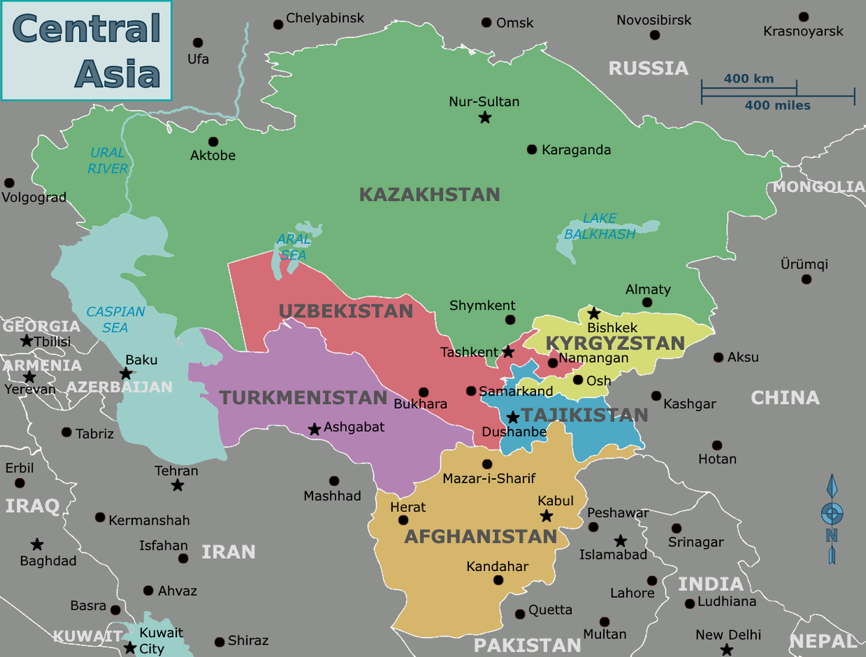Description

Disclaimer: Copyright infringement not intended.
Context
- Earlier this week, China convened an online meeting of trade ministers of the grouping known as C+C5 — China and the five Central Asian republics, namely Uzbekistan, Kazakhstan, Tajikistan, Turkmenistan, and Kyrgyzstan.
- Last month, Kazakhstan, Kyrgyzstan, Tajikistan, and Uzbekistan received Nowroz messages from President Xi Jinping.
About Chinese diplomacy in Central Asia
Recent developments
- The first C+C5 summit was held in virtual format on January 25 last year, to commemorate the 30th anniversary of diplomatic relations.
History
- China shares a long history of trade, cultural, and people-to-people links with the Central Asian region, which lies on the ancient Silk Route.
- Modern China’s involvement with the region began with the break-up of the Soviet Union in 1991, when it moved deftly to formalise its boundaries with Kyrgyzstan, Kazakhstan, and Tajikistan, as well as Russia.
- Diplomatic relations were established in January 1992, and China’s relationship with the region was institutionalised as the Shanghai Five, the forerunner of the Shanghai Cooperation Organisation (SCO).
Economic Interests
- Central Asia was a readymade market for cheap exports, and gave China overland access to markets in Europe and West Asia.
- The region is resource-rich, with massive gas and oil reserves, and strategic minerals such as uranium, copper, and gold. It grows foodgrains and cotton.

Strategic interest
- China also had another priority in its relationship with these countries — to ensure peace in Xinjiang Autonomous Region, which forms its frontier with Central Asia.
Xi’s Belt and Road
- To the landlocked region, China offered access to the Pacific Ocean and East Asia.
- President Xi launched his Belt and Road Initiative, a modern version of the Silk Road, during his 2013 visit to the Kazakh capital Almaty. As many as 51 BRI projects are said to be located in the country.
- Beijing has also pumped billions of dollars into Uzbekistan and the other three smaller countries in the region.
Challenges
- Beijing’s targeting of the Muslim population of Xinjiang has triggered resentment in these countries, where Islam is the principal religion.
- The Uighur live across Central Asia, and Xinjiang has significant Kazakh and Uzbek populations that have been affected by the Chinese crackdown.
- The resentment, including at the increasing presence of Chinese workers and rapid land acquisitions by China in these countries, has periodically boiled over in public protests.
- China now jostles with Russia as the region’s foremost trading partner.
Future projects
- Talks are on for transport projects and logistics linking all countries in the Central Asian region to Lianyungang seaport on the Yellow Sea in China’s Jiangsu province.
- China is investing in the expansion of the Horgos land port in Xinjiang, adding connectivity into Central Asia and Europe.
- President Xi is also pressing Uzbekistan to finish the construction of the China-Uzbekistan-Kyrgyzstan railway, and begin the implementation of the Uzbekistan-Kazakhstan-China-Laos-Thailand-Malaysia transport corridor.
Grand Plan
- Xi has reportedly told Central Asian leaders that he is “eager to discuss a grand plan to develop relations” with them.
Russian angle
- The region is still economically dependent on Russia, which is also Central Asia’s net security provider, even though the Collective Security Treaty Organisation (CSTO), comprising six countries, three of them in central Asia, is fraying somewhat — and the Ukrainian invasion has given rise to fears that a security relationship with Moscow could prove to be a double-edged weapon.

India and Central Asia
- In 2022, Prime Minister hosted a virtual summit of the C5 — India’s first engagement with the Central Asian nations collectively at the highest level.
- Its relationships in the region, including in the SCO, remain security-driven.
- While India has trading ties with these countries, it is hobbled by the absence of a land route to Central Asia, with Pakistan denying it passage and Afghanistan being uncertain territory after the Taliban takeover.
- The Chabahar port in Iran offers an alternative route, but it is not fully developed yet.
- There have been suggestions that India should provide connectivity for people and trade in Central Asia through “air corridors”, as it had done for Afghanistan.
MUST-READ ARTICLE:
India Central Asia Relations: https://www.iasgyan.in/daily-current-affairs/india-central-asia-relations-35
|
PRACTICE QUESTION
Q) India’s relationships in the Central Asian region, including in the SCO, remain security-driven. Critically Analyse. (250 words)
|

https://indianexpress.com/article/explained/explained-global/china-and-central-asia-xi-jinping-russia-visit-vladimir-putin-8567782/












